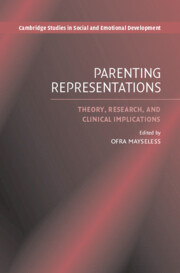Book contents
- Frontmatter
- Contents
- List of Illustrations
- List of Tables
- List of Appendixes
- List of Contributors
- Preface
- Acknowledgments
- Part One Theoretical Perspectives
- Part Two Research Applications
- 4 Communicating Feelings: Links Between Mothers' Representations of Their Infants, Parenting, and Infant Emotional Development
- 5 The Dual Viewpoints of Mother and Child on Their Relationship: A Longitudinal Study of Interaction and Representation
- 6 Modeling and Reworking Childhood Experiences: Involved Fathers' Representations of Being Parented and of Parenting a Preschool Child
- 7 Maternal Representations of Parenting in Adolescence and Psychosocial Functioning of Mothers and Adolescents
- 8 Like Fathers, Like Sons? Fathers' Attitudes to Childrearing in Light of Their Perceived Relationships with Own Parents, and Their Attachment Concerns
- Part Three Clinical Implications
- Index
- Cambridge Studies in Social and Emotional Development
- References
6 - Modeling and Reworking Childhood Experiences: Involved Fathers' Representations of Being Parented and of Parenting a Preschool Child
from Part Two - Research Applications
Published online by Cambridge University Press: 10 July 2009
- Frontmatter
- Contents
- List of Illustrations
- List of Tables
- List of Appendixes
- List of Contributors
- Preface
- Acknowledgments
- Part One Theoretical Perspectives
- Part Two Research Applications
- 4 Communicating Feelings: Links Between Mothers' Representations of Their Infants, Parenting, and Infant Emotional Development
- 5 The Dual Viewpoints of Mother and Child on Their Relationship: A Longitudinal Study of Interaction and Representation
- 6 Modeling and Reworking Childhood Experiences: Involved Fathers' Representations of Being Parented and of Parenting a Preschool Child
- 7 Maternal Representations of Parenting in Adolescence and Psychosocial Functioning of Mothers and Adolescents
- 8 Like Fathers, Like Sons? Fathers' Attitudes to Childrearing in Light of Their Perceived Relationships with Own Parents, and Their Attachment Concerns
- Part Three Clinical Implications
- Index
- Cambridge Studies in Social and Emotional Development
- References
Summary
Abstract
We examine intergenerational parenting representations of 49 highly educated, married fathers from dual career families who shared childrearing with their wives. Responding to the Parent Attachment Interview, the men discussed similarities and differences between their remembered childhood relationships with mother and father and their current relationship with a preschool son (N = 27) or daughter (N = 22). Rather than globally identifying with one parent (whether father or mother), a relatively high percentage of the men were selective in the positive qualities they modeled and the disappointing qualities they rejected in either or both parents. Overall, they described more intergenerational differences (reworking of the remembered relationships from childhood) than similarities (modeling themselves after their parents). Concerning similarities, men in our study were much more likely to adopt their mothers than their fathers as influential models with respect to affection/attachment/communication and, to a slightly lesser extent, discipline practices. In the domain of joint father–child activities, the percentage of men who saw themselves as similar to their fathers was higher. Findings are discussed from the perspective of attachment theory and societal change in fatherhood ideals.
The notion that parent–child relationship patterns and representations are transmitted across generations has a long history in the clinical literature on child maltreatment and parental depression. In an influential synthesis of this literature, Belsky (1984; p. 83) hypothesized that “determinants of parenting highlighted by child abuse research might also play a role influencing parenting that falls within the normal range of functioning.”
- Type
- Chapter
- Information
- Parenting RepresentationsTheory, Research, and Clinical Implications, pp. 177 - 207Publisher: Cambridge University PressPrint publication year: 2006
References
- 12
- Cited by



